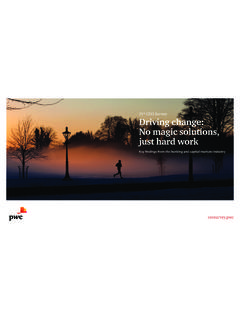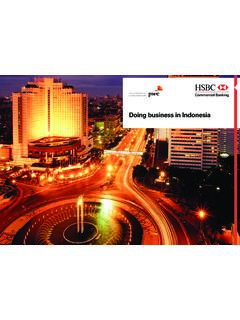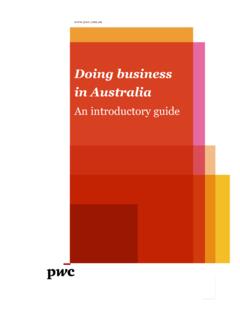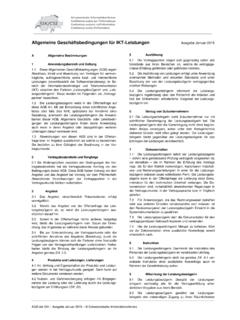Transcription of Blurred lines: How FinTech is shaping Financial Services
1 Blurred lines: How FinTech is shaping Financial than 20% of FS business is at risk to FinTechs by 2020 57%are unsure about or unlikely to respond to blockchain technologyGlobal FinTech ReportMarch 20162 PwC Global FinTech ReportTitleKey messagesBlockchain: an untapped technology is rewriting the FS rulebookHeading for bargain basement FS? FinTech is slashing costsThe free lunch is over: FS must leverage the FinTech ecosystemFinTech is shaping FS from the outside inWhere traditional Financial institutions have failed, FinTechs are succeedingDisintermediation: FinTech s most powerful weaponTime to get off the bench: over 20% of FS business at risk to FinTechsContentsIntroduction 3 Section 1: The epicentre of disruption 5 Section 2: Emerging FinTech trends on the radar 9 Section 3: An industry under siege 19 Section 4.
2 Offence is the best defence 22 Conclusion 29 Appendix 30 Summaries of the trends 31 DeNovo 34 Contacts 352 PwC Global FinTech Report3 PwC Global FinTech ReportIntroductionIt is difficult to imagine a world without the internet or mobile devices. They have become core elements of our lifestyle and have brought a high degree of disruption to virtually every area of business. The Financial Services (FS) industry is no exception; the digital revolution is transforming the way customers access Financial products and Services . Although the sector has experienced a degree of change in recent years, the constant penetration of technology-driven applications in nearly every segment of FS is something new.
3 At the intersection of finance and technology lies a phenomenon that has been accelerating the pace of change at a remarkable rate and is reshaping the industry s status quo it is called FinTech . What is FinTech ? FinTech is a dynamic segment at the intersection of the Financial Services and technology sectors where technology-focused start-ups and new market entrants innovate the products and Services currently provided by the traditional Financial Services industry. As such, FinTech is gaining significant momentum and causing disruption to the traditional value chain. In fact, funding of FinTech start-ups more than doubled in 2015 reaching $ , up from $ in 2014 based on the companies included on our DeNovo platform.
4 Cutting-edge FinTech companies and new market activities are redrawing the competitive landscape, blurring the lines that define players in the FS sector (see Figure 1). Figure 1: FinTech is a complex ecosystemSource: PwCRegulators and governmentC. Infrastructure playersA. FS institutionsB. Tech companiesD. Start-upsInvestors, incubators and acceleratorsConsumers and usersEmerging technologies and toolsFinTech is shaping FS from the outside in4 PwC Global FinTech ReportOur objectives and approachThis report assesses the rise of new technologies in the FS sector, the potential impact of FinTech on market players and their attitudes to the latest technological developments.
5 Additionally, it offers strategic responses to this ever-changing environment. Our analysis is based on the following:1) Primary data derived from the results of a global survey that includes feedback from a broad range of players from the world s top Financial institutions. For this study, we surveyed 544 respondents, principally Chief Executive Officers (CEOs), Heads of Innovation, Chief Information Officers (CIOs) and top-tier managers involved in digital and technological transformation. Our survey was distributed to leaders in various segments of the FS industry in 46 countries (see Figure 2).
6 12) Insights and proprietary data from DeNovo, PwC s Strategy& platform composed of a 50-member team of FinTech subject matter specialists, strategists, equity analysts, engineers and technologists with access to over 40,000 public and proprietary data sources. In the first section, we explore FS market participants perspectives on disruption. Next, we highlight the main emerging FinTech trends in the various FS industries and the readiness of the market to respond to these trends. Finally, we offer suggestions about how market players should strategically approach FinTech . 1 Please refer to the appendix for more information about our survey 2.
7 Type of survey respondentsSource: PwC Global FinTech Survey 2016 Global breakdownn Bank 30%n Asset and wealth management company 21%n FinTech company 20%n Insurance company 14%n Other* 11%n Fund transfer and payments institution 4% FinTech is a dynamic segment at the intersection of the Financial Services and technology sectors where technology-focused start-ups and new market entrants innovate the products and Services currently provided by the traditional Financial Services industry.*Other includes consultants, national supervisory and international Financial PwC Global FinTech ReportBanking and PaymentsInsurance, Asset Management and Wealth ManagementUp to 22% of business at risk by 2020Up to 28% of business at risk by 2020 The epicentre of disruption 1 New digital technologies are in the process of reshaping the value proposition of existing Financial products and Services .
8 While we should not underestimate the capacity of incumbents to assimilate innovative ideas, the disruption of the Financial sector is clearly underway. And consumer banking and payments, already on the disruption radar, will be the most exposed in the near future, followed by insurance and asset management. We thought we knew our customers, but FinTechs really know our customers. A senior executive at a global banking PwC Global FinTech Disruption targets mostly consumer banking and payments In keeping with changes already underway, the majority of our survey participants see consumer banking and fund transfer and payments as the sectors most likely to be disrupted over the next five years (see Figure 3).
9 In consumer and commercial lending, for example, the emergence of online platforms allows individuals and businesses to lend and borrow between each other. Lending innovation also manifests itself in alternative credit models, use of non-traditional data sources and powerful data analytics to price risks, rapid customer-centric lending processes, and lower operating recent years, the payments industry has also experienced a high level of disruption with the surge of new technology-driven payments processes, new digital applications that facilitate easier payments, alternative processing networks and the increased use of electronic devices to transfer money between : FinTech s most powerful weaponFigure 3.
10 Areas of disruptionSource: PwC Global FinTech Survey 2016 Consumer bankingFund transfer & paymentsInvestment & wealth managementSME bankingBrokerage servicesProperty & casualty insurance/ Life insuranceCommercial bankingInsurance intermediaryMarket operators & exchangesFund operatorsInvestment bankingReinsurance0%20%10%30%40%50%60%80 %70%Which part of the Financial sector is likely to be the most disrupted by FinTech over the next 5 years? All industriesBanking and capital marketsAsset and wealth managementInsurance/ReinsuranceFund transfer and paymentsConsumer banking and fund transfers & payments are likely to be the most disrupted sectors by 20207 PwC Global FinTech Asset management and insurance are also on the disruption radar Although a high level of disruption triggered by FinTech is already beginning to reshape the nature of lending and payment practices, a second wave of disruption is making inroads in the asset management and insurance sectors.
















